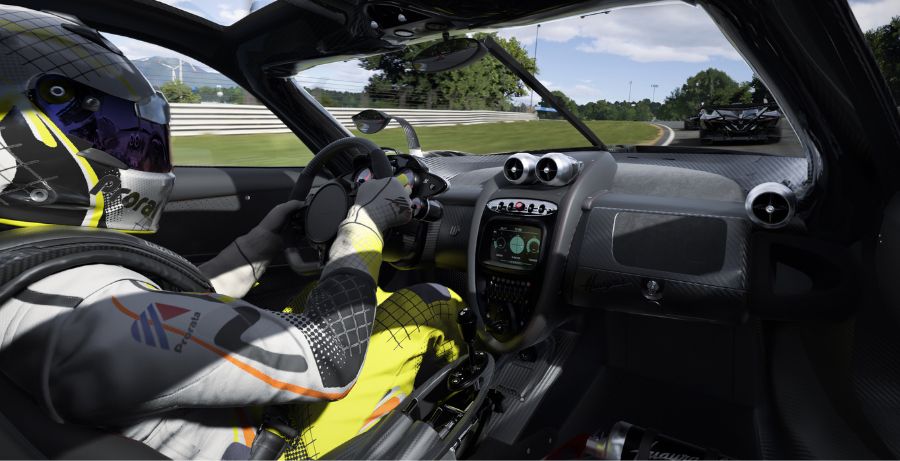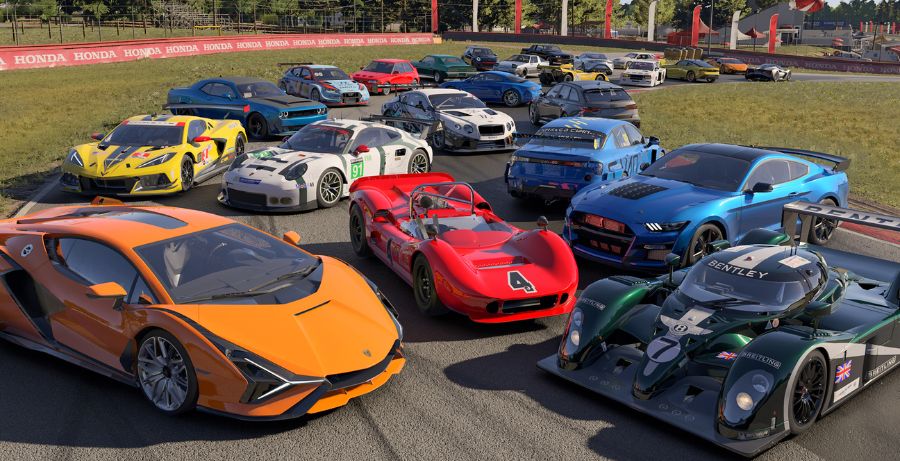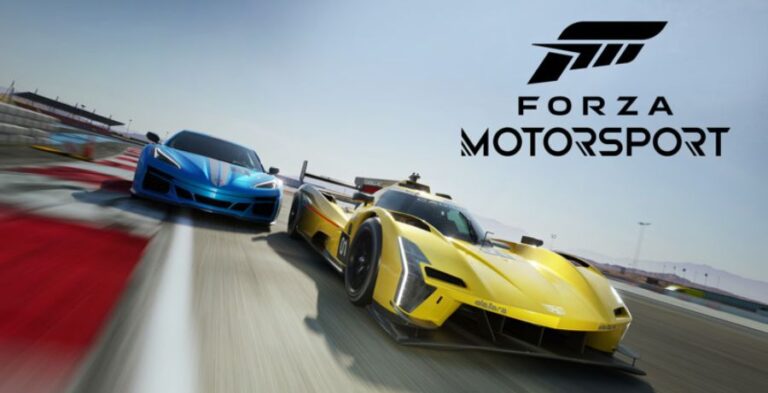Xbox Game Studios’ Turn 10 has found its footing as the premier studio to create masterful racing sim games. Creators of the famed Forza Motorsport series, they’ve always found ways to push the envelope on not only racing games but gaming in general. The studio is regularly used as a flagship studio that shows just what Xbox consoles can do with their beautiful, almost realistic-looking games. With 2023’s release, Forza Motorsport (Forza Motorsport 8), they have done it again. But is this reset just what the series needs to be: Xbox’s flagship racing game for this whole new generation?
Throughout the eight entries, it’s clear that Turn 10 loves racing and, more importantly, loves cars. While there is no direct story told throughout Forza Motorsport 8, there are celebrations throughout it in its “campaign mode,” titled Builders Cup. This is a five-tour series full of races focusing on one type of car.
Each Cup in a series starts off with an introductory video highlighting the history of that car type and how it’s evolved over the years. What follows after you buy your preferred car to be used is five to six races that try to teach you all it can about your car and yourself as a racer.
Every race breaks down into three different segments. The first is tuning. As you level your car up with each turn, each lap, and each race, you unlock more parts you can change out. If you’re a new player and are unsure how to change things up, the auto-upgrade is a great tool. It’s quick and tells you how exactly your vehicle has improved.
If you want to get into the nitty-gritty, you can. This also relies on leveling up your car to get new parts. Every new part added to your car unlocks even more features that can be tuned. What’s great about tuning is if you want to learn how you can get even more out of the car you’ve been driving, the game will tell you how each little change to the car you make affects the driving. This goes into where Forza Motorsport 8 excels the most.

What this game wants you to do is to learn and to be the best driver you can be. How does it do this? By feeding you a lot of information and letting you choose how much information you want to take in to improve. This is shown best in the second phase of races, the practice laps. Every race in the Builders Cup requires you to complete a predefined number of laps on the track before you compete in it.
During practice laps, you’re given two goals. The first is to complete X number of laps. The second is optional and for beating a time that’s dependent on your selected difficulty. As you drive around the track, you’ll get specific times for certain corners. The more laps you do, the more you can learn how you can take these turns faster. For instance, maybe breaking all the way won’t be as strategic as you thought. Or, you can cut a corner more than you thought.
All of this happens without you realizing you’re thinking all these different ways. What really helps is each segment gives a one through ten score, which adds to your car’s experience. Whenever you complete a segment, that score pops up. This happens during the main event, too. Not just during practice laps.
If you want to take all this learning to an even deeper level, you can press Up on the d-pad to bring up different displays, which gives you a lot of information. One screen gives you information on the friction on each tire as you’re turning. Another shows tire temperatures and how they’re affecting your car. A third goes deeper into all the different metrics which is affecting your acceleration. All of this information is readily available to you to take in at your own pace.
All of this culminates in the final race. These are longer, eight to fifteen-minute races against twenty-three drivatars, or AI drivers named after other actual racers, all competing for first place. Depending on what place you get, you get more points for the overall ranking of that series. It’s a surprising amount of investment for a single race, let alone a five to six-race series. The biggest negative of all this is it’s also a major time investment for just one race. On average, each race took about fifteen to twenty minutes to go from starting to crossing the finish line for the last time, and none of these segments are skippable.

While starting off an event or for the first couple of races you complete, it’s understandable that you’d do a couple of practice laps. You need to get used to your new car. But after completing a whole series, maybe adding a skip feature to the practice laps would be nice. Or, at minimum, letting you move on to the main race after you beat the minimum time in the practice lap.
Even then, the game lets you push yourself. It’s not building up difficulty as you progress through the Builders Cup. You set what you’re most comfortable with before each race, which is pretty nice to an extent. The difficulty is broken down into many facets, like the drivatar difficulty from one to ten. Another lets you define how realistic you want to simulate a race by just letting you race, all the way to simulating tire wear and fuel levels and increasing penalties for colliding or going off the track.
The third is choosing where exactly you start each race for the main event. What’s really fascinating about this last part is the game estimates what finishing place you’ll get in a race depending on where in the starting block you start. And this is all dependent on your skill level. If you nail the practice laps, you may be recommended to start in below twelfth place out of twenty-four. If that happens consistently, the game then starts suggesting raising the drivatar difficulty level. And if it gets too hard? You can always change it all for the next race.
So what’s the incentive to make the game harder or choose a starting place that isn’t just third every time, besides just for a personal challenge? Money. The harder the game is, the more simulation items you add to your experience, and the more your final payout is. Then, the more money you have, the more cars you can buy or customization options you can invest in. Basically, if you push yourself, you are opening your own options.
Where I’ve found the most fun has been multiplayer. there are numerous options for multiplayer that let you challenge yourself against the world in many different ways. The biggest standout modes are rivals and featured multiplayer. The first is like a time trial, where the time you’re trying to beat is another player’s best lap. The best way this has improved compared to other rival races in other racing games is once you’ve beaten one rival, the game already has the next rival lined up. Your next lap after beating a rival immediately as you go up against your next one. There are no more menus or kicking you out to one to pick your next rival. Plus, there are rival races for every single race and car class, too. The amount of what you can get out of Rivals is nearly limitless.

For the Featured Multiplayer, this is the flagship multiplayer mode. It’s very similar to a Builder’s Cup race but with up to twenty-four other players. It has a practice mode where you can race around the track, but starting placements is based on your qualifying time. In a separate mode within the practice segment, you do your official practice run. You need to get your best lap time in three laps. Then, your starting placement is dependent on how well the other twenty-three players complete their practice laps. All of this has to be done within the fifteen to twenty-minute time limit for all players to complete their qualifying laps and practice.
Then, you’re in the minute pre-race starting line-up. These races require you to pay attention to your fuel, so you can choose how much fuel you start off with. How does this change your race? The less fuel you have, the less weight you have. So, you can accelerate faster. But you do run the risk of potentially running out of fuel mid-race. And you can see how your fellow racers are making these selections to be extra competitive. Nothing is ever a surprise.
Again, going back to the biggest negative for the Builders Cup, Featured Multiplayer is a time commitment. Depending on when you join a race, you may be there for a good thirty to forty minutes just for one event! That’s a lot of time if you want to take part in one of these. There are quick play events, but it was hard to tell during the review period how these played out, as the main focus on multiplayer testing was on Featured Multiplayer.
So, did Turn 10 push the envelope yet again on their graphical prowess? Absolutely. Forza Motorsport 8 is nearly photo-realistic. The cars feel like they were ripped from real life and plopped onto the different racetracks. Plus, with dynamic lighting and weather, seeing a race change from sunset and the sun glaring into your eyes to a rainy night were breathtaking moments. Especially with how it affected my own view on trying to see the attack line and understand the racetrack better as I was driving.
The new lighting is most noticeable when it rains in-game. Seeing the shine off the ground and the wetness on the car made the changes to the racetrack make more sense, not just seeing the rain, but why the racetrack felt more slippery after the rain stopped. In other words, the updates to lighting make this simulation racing game feel much more believable in immersing oneself into believing you are on these tracks.

Plus, it’s astonishing how each car feels so unique, too. A 1960s beater will drive completely differently than a 2023 Lamborghini. Even with that being expected, the differences between even cars of the same class car type or year are hard to describe until you get your own hands on the controller. But it’s so interesting how, without realizing it, you’ll soon notice that similar cars will have different feels with turning, and you’ll quickly learn how to approach turns differently, how best to accelerate out of turns, how to stop yourself from spinning out on different terrains or weather because all of that does feel different depending on which vehicle you pick. The amount of time invested to get each car to feel just right in its own way is an accomplishment in its own right, especially with the sheer amount of cars available.
All that being said, Forza Motorsport 8 is not for everyone. It’s clear this game wants you to learn how to race and have you appreciate how much goes into being an actual racer. But that focus can be alienating. The time investment for each race can be daunting or boring at times. You may just want to race and go on to the next race and kick butt. But with nothing being skippable for each segment of a race, and the overwhelming amount of information that is available to you may push you away if you’re just not in the mood for all of that. Even if most of it is optional, the time commitment isn’t. So know what exactly you’re in the mood for when you boot up the game to make sure you don’t burn yourself out. But if you really do push yourself and learn all the game teaches you, you’ll find a new appreciation for the art of racing that you’ve never had before.
Forza Motorsport 8 is masterfully made. The driving feels fantastic. The races at first are exhilarating. Plus, all multiplayer modes are enjoyable, and hours will pass in the blink of an eye. Yet in that same regard, Turn 10’s latest entry in their famed racing series does not feel friendly to newcomers. There are several choices that add tedium that fans of racing sim games may enjoy and be overwhelming or deterring for newcomers. But if you take in all that the game wants to teach you, you will find one of the best racing games made to date.
Forza Motorsport is available now for Xbox Series X|S and PC and with Xbox Game Pass.
Forza Motorsport
-
Rating - 9/109/10
TL;DR
Forza Motorsport 8 is masterfully made. The driving feels fantastic. The races at first are exhilarating. Plus, all multiplayer modes are enjoyable, and hours will pass in the blink of an eye.







